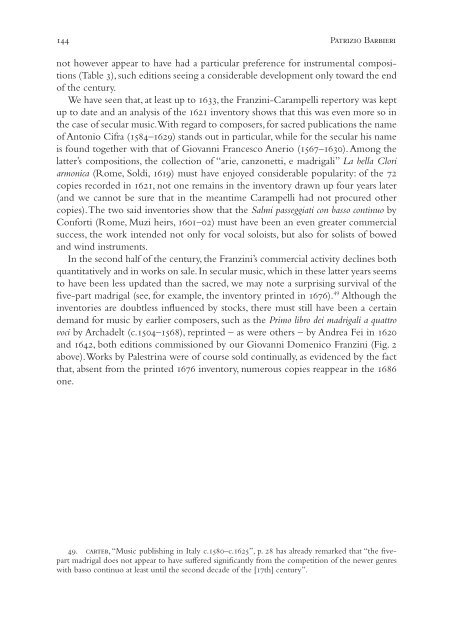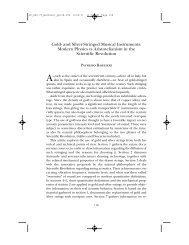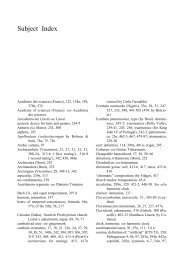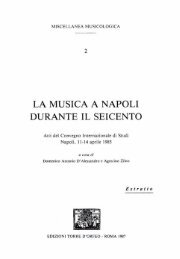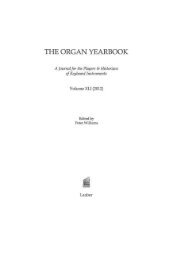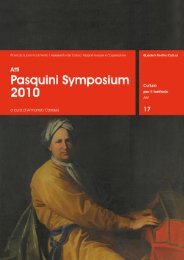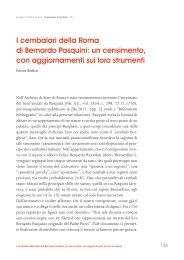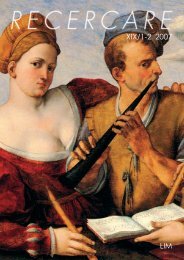Music-selling in seventeenth-century Rome: three ... - Patrizio Barbieri
Music-selling in seventeenth-century Rome: three ... - Patrizio Barbieri
Music-selling in seventeenth-century Rome: three ... - Patrizio Barbieri
You also want an ePaper? Increase the reach of your titles
YUMPU automatically turns print PDFs into web optimized ePapers that Google loves.
144 <strong>Patrizio</strong> Barbier<strong>in</strong>ot however appear to have had a particular preference for <strong>in</strong>strumental compositions(Table 3), such editions see<strong>in</strong>g a considerable development only toward the endof the <strong>century</strong>.We have seen that, at least up to 1633, the Franz<strong>in</strong>i-Carampelli repertory was keptup to date and an analysis of the 1621 <strong>in</strong>ventory shows that this was even more so <strong>in</strong>the case of secular music. With regard to composers, for sacred publications the nameof Antonio Cifra (1584–1629) stands out <strong>in</strong> particular, while for the secular his nameis found together with that of Giovanni Francesco Anerio (1567–1630). Among thelatter’s compositions, the collection of “arie, canzonetti, e madrigali” La bella Cloriarmonica (<strong>Rome</strong>, Soldi, 1619) must have enjoyed considerable popularity: of the 72copies recorded <strong>in</strong> 1621, not one rema<strong>in</strong>s <strong>in</strong> the <strong>in</strong>ventory drawn up four years later(and we cannot be sure that <strong>in</strong> the meantime Carampelli had not procured othercopies). The two said <strong>in</strong>ventories show that the Salmi passeggiati con basso cont<strong>in</strong>uo byConforti (<strong>Rome</strong>, Muzi heirs, 1601–02) must have been an even greater commercialsuccess, the work <strong>in</strong>tended not only for vocal soloists, but also for solists of bowedand w<strong>in</strong>d <strong>in</strong>struments.In the second half of the <strong>century</strong>, the Franz<strong>in</strong>i’s commercial activity decl<strong>in</strong>es bothquantitatively and <strong>in</strong> works on sale. In secular music, which <strong>in</strong> these latter years seemsto have been less updated than the sacred, we may note a surpris<strong>in</strong>g survival of thefive-part madrigal (see, for example, the <strong>in</strong>ventory pr<strong>in</strong>ted <strong>in</strong> 1676). 49 Although the<strong>in</strong>ventories are doubtless <strong>in</strong>fluenced by stocks, there must still have been a certa<strong>in</strong>demand for music by earlier composers, such as the Primo libro dei madrigali a quattrovoci by Archadelt (c.1504–1568), repr<strong>in</strong>ted – as were others – by Andrea Fei <strong>in</strong> 1620and 1642, both editions commissioned by our Giovanni Domenico Franz<strong>in</strong>i (Fig. 2above). Works by Palestr<strong>in</strong>a were of course sold cont<strong>in</strong>ually, as evidenced by the factthat, absent from the pr<strong>in</strong>ted 1676 <strong>in</strong>ventory, numerous copies reappear <strong>in</strong> the 1686one.49. carter, “<strong>Music</strong> publish<strong>in</strong>g <strong>in</strong> Italy c.1580–c.1625”, p. 28 has already remarked that “the fivepartmadrigal does not appear to have suffered significantly from the competition of the newer genreswith basso cont<strong>in</strong>uo at least until the second decade of the [17th] <strong>century</strong>”.


